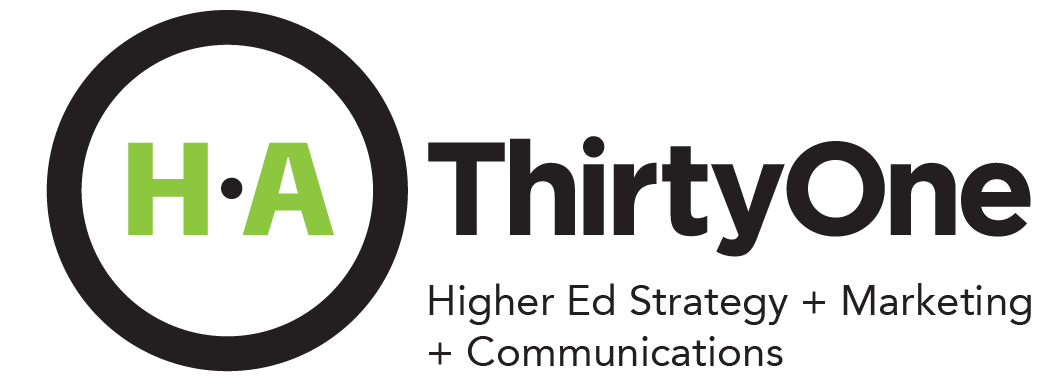Plenty has been written about how the “Great Resignation” is impacting higher ed – from sage words by HA ThirtyOne consultant Angie Vicars and colleagues in the field like Jaime Hunt of Miami University to industry megaphone The Chronicle.
Yes, people are leaving higher ed, but what can be done to retain them, as well as help the field continue to grow and attract top talent?
Keep and Expand Flexibility
Most campuses are structured in ways that don’t recognize the time employees work unless they are on campus. Though there are differences in the way faculty and staff time are typically assessed, the pandemic has forced institutions to rely on off-campus options for both groups, making it high time to recognize that a heck of a lot of work happens outside of the university proper.
This is one of the guiding principles on which HA ThirtyOne was founded: it’s the quality of the work that matters, not where it gets done.
HA ThirtyOne had been an outlier for embracing this philosophy. Then COVID hit. And the rest of the world was thrust into doing by necessity what we had already chosen to do by design. Organizations in which flexibility never ranked too high on their list of core values were suddenly forced to grapple with the challenge of trusting staff to do their work without the supervisory controls automatically derived from occupying the same workspaces – a fact that revealed the absence of something arguably even more consequential: trust.
Rather than looking forward to getting back to normal, organizations throughout higher ed should embrace a truly forward-looking vision by fostering a new normal in the form of innovative ways of working and learning for which a firm commitment to flexibility and trust are not optional.
Leverage Unique Benefits
Tuition exchange benefits used to be a surefire way to garner a healthy pool of candidates, particularly for staff positions. But there are many more benefits that institutions can offer. They include access to on-campus facilities such as libraries, meeting spaces, gyms and wellness centers, tickets to sporting events and live entertainment, even free or discounted dining-hall meals.
The problem is that these perks are usually so “baked in” to the system that hiring and HR managers neglect to promote them as benefits. They’re generally not codified in a manner that encourages employees to take advantage of them. Making sure staff feel included as full members of campus isn’t only good for recruiting and retaining top talent, it’s also crucial for breaking down silos and developing a genuine sense of community.
Sabbaticals may be the most powerful untapped staff benefit. Traditionally seen as only for faculty, enabling staff to partake in the sabbatical experience could help with employee morale, development, and retention. Patagonia embraced this concept long ago, and variants of it are appearing at companies as large and diverse as CharlesSchwab, Adobe, Bain & Co., Alta Planning & Design, PayPal, and GenenTech. In the world of higher ed, just as faculty are expected to dedicate sabbatical time to their own research, so would staff. This isn’t PTO; it’s bracketed time to reinvest in employees so they can reinvest in themselves. Everyone wins. (For extra credit on the rationale and importance of ensuring time for personal pursuits and “refilling the well,” check out Overtime: Why We Need a Shorter Working Week, by Will Stronge and Kyle Lewis.)
One Size Does NOT Fit All
It’s a mistake to assume that benefits popular 20 years ago are still top attractors today, or, simply stated, that one size fits all.
To that end, organizations should poll employees in annual surveys about the kinds of benefits they want. In addition to helping leadership stay current on new ideas and interests, the survey could also serve as a platform to boost benefits awareness in general, particularly for employees with longer tenures who may not keep up with the latest offerings.
Real Paths (or Discussions) for Growth and Advancement
Why are people resigning in such great numbers? Roles lacking clear paths for advancement is one of the most common reasons I’ve heard. The only visible way to move up was to move out. This is a problem of leadership. If a team member is happy in their current role, awesome! But a conscientious leader will always maintain an open dialogue about any new ideas they may have about their own career trajectory. These ongoing conversations can not only allow them to apply new interests and talents to other areas of the organization, but also help to train that great new hire to take their place and make the team even stronger.
I’ve been on this soapbox long enough to know that employees who want these kinds of changes are often skeptical that their organization will be able to adopt them. I’ll agree that trying to tackle all of these ideas at once would be difficult. So, what to do first? My recommendation: just start having the conversation. A good, open discussion guided by the premise “how we can” instead of “why we can’t” will generate a wealth of new ideas, and like a magnet, pull the best ones to the top.
Karyn Adams brings her 20+ years of higher ed experience, earned inside the academy and as an external partner, to her service as Principal and Creative Director for HA ThirtyOne. She’s passionate about making great work and making work a great experience.
